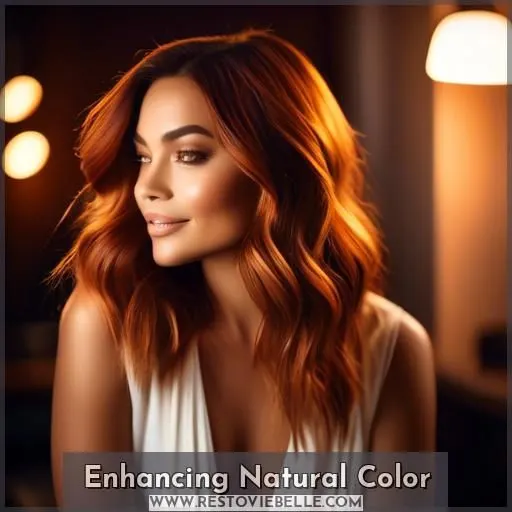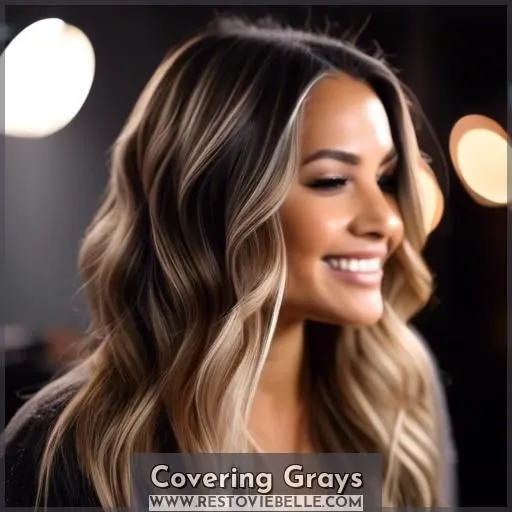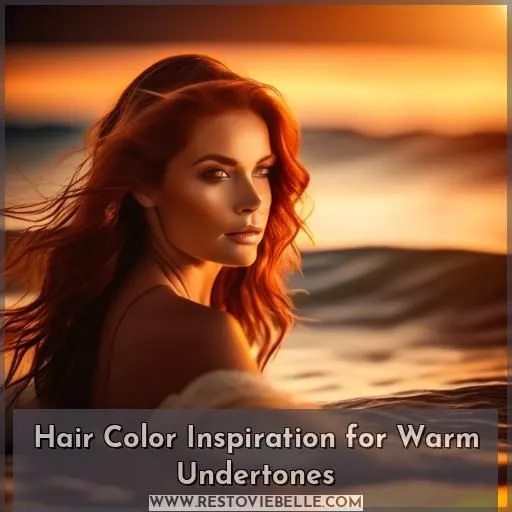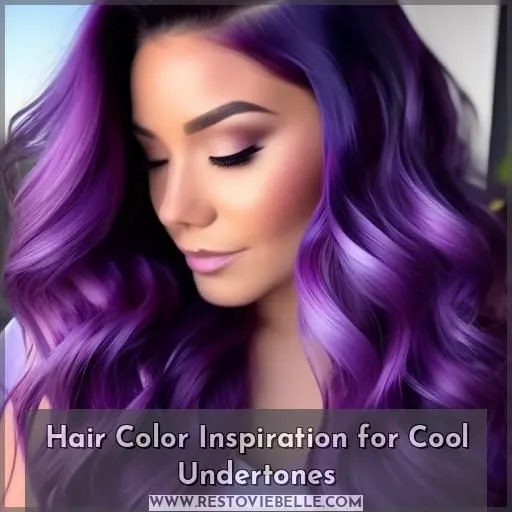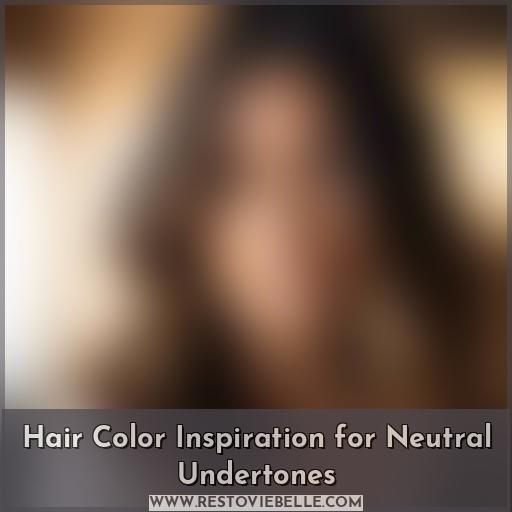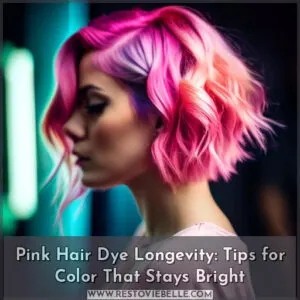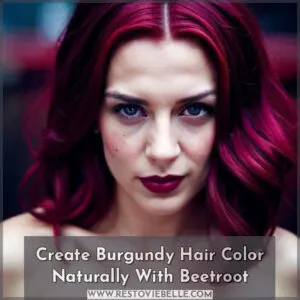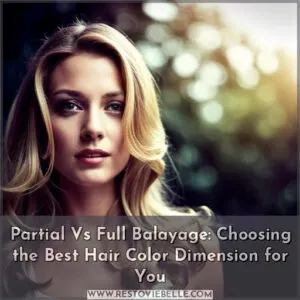This site is supported by our readers. We may earn a commission, at no cost to you, if you purchase through links.
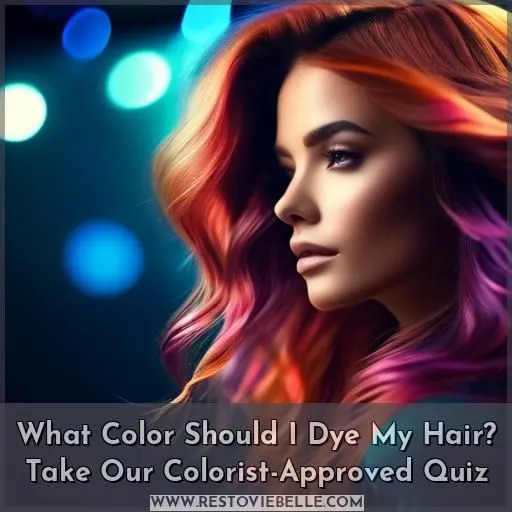 Unleash your vibrant essence by dyeing your hair a hue that resonates with your inner radiance.
Unleash your vibrant essence by dyeing your hair a hue that resonates with your inner radiance.
Our quiz unravels the perfect shade tailored to your unique features.
It allows you to confidently embrace a transformative look that ignites confidence and self-expression.
Dive into a captivating exploration of tones that harmonize with your complexion.
It accentuates your individuality while fostering a sense of empowerment and belonging.
Table Of Contents
Key Takeaways
- Consider your hair’s texture, health, current color, skin tone, and undertones before dyeing your hair.
- Hair texture, including porosity and thickness, can affect how well your hair color takes and how long it lasts.
- Your natural hair color can serve as a foundation for your new look and influence the shade you choose.
- Skin tone plays a significant role in determining which colors will complement your complexion and enhance your natural beauty.
What Color Should I Dye My Hair?
To determine the best color for your hair dye, consider factors such as your natural hair color, skin tone, and desired level of commitment. It’s generally recommended to choose a color within two shades of your natural hair color, as your hair shade often matches your complexion.
Additionally, consider your skin undertones, which can influence which shades look best on you. For example, if you have a warm undertone, colors like chocolate, light brown, and auburn might be flattering, while cool undertones might look better with platinum blonde, smoky brown, or wheat blonde.
Factors to Consider Before Dyeing Hair
Before dyeing your hair, consider your hair’s texture, health, current color, skin tone, and undertones. These factors will help you choose a shade that complements your natural features and minimizes damage.
Hair Texture (porosity, Thickness)
Before dyeing your hair, it’s crucial to consider your hair texture, which includes both porosity and thickness. Porosity refers to your hair’s ability to absorb moisture, and it can affect how well your hair color takes to your hair and how long it lasts. If your hair is highly porous, it may lose color faster, leading to fading. On the other hand, low porosity hair may require more time and effort to process the dye, as the cuticle is less likely to absorb the color.
Hair texture also plays a role in how well your hair color ideas will turn out. For example, fine hair may not hold a curl well, while thick hair can be more difficult to style due to its thickness. When it comes to hair color, you’ll want to consider both the texture and porosity of your hair to ensure the best results.
To enhance your natural hair color, you can use hair glosses or glazes. These treatments can add shine and depth to your hair, making it look healthier and more vibrant. They’re also less damaging than traditional hair dyes, as they don’t contain the harsh chemicals found in permanent dyes.
When choosing a hair color, it’s essential to consider your skin tone and undertones. Warm undertones can look great with golden or honey blonde shades, while cool undertones may suit ash or baby blonde hues. Neutral undertones can work with a variety of shades, from light brown to dark chocolate.
Ultimately, the key to finding the perfect hair color is to consider your hair texture, porosity, and natural hair color, as well as your skin tone and undertones. With the right approach, you can achieve a look that complements your features and makes you feel confident and beautiful.
Hair Health (damage, Past Processing)
Before dyeing your hair, it’s crucial to consider its health. Previous chemical treatments, bleach damage, and strand weakening can impact how your new color will look. Hair color tips include assessing your hair’s chemical sensitivity and the potential for color fading.
Current and Natural Hair Color
When considering a hair color change, it’s essential to take into account your current and natural hair color. Your natural hair color can serve as a foundation for your new look, and understanding your hair history can help guide your decision-making process.
- Dyeing motivation: Are you looking to make a bold statement, enhance your features, or cover grays? Your motivation can influence the shade you choose.
- Hair commitment: Consider your willingness to maintain the color, as some shades may require more time, money, and energy to upkeep.
- Shade maintenance: Some hair colors may fade quickly, while others may require more frequent touch-ups.
- Hair color for current hair color: If you have a lighter natural hair color, you may want to stick with a lighter shade to avoid a stark contrast. Conversely, if your natural hair color is darker, a darker shade may be more flattering.
- Hair color for natural hair color: Your natural hair color can serve as a guide for choosing a shade that complements your skin tone and undertones.
- Hair color for cool undertones: Cool undertones are best suited for cool-toned hair colors, such as ash blonde, dark brunette, and reds with violet or pink tones.
- Hair color for warm undertones: Warm undertones are best suited for warm-toned hair colors, such as golden or honey blonde, caramel or mahogany brunette, and scarlet or russet red.
- Hair color for neutral undertones: Neutral undertones can be paired with a variety of shades, including light brown, mushroom brown, and dark chocolate.
By considering these factors, you can find a hair color that complements your current and natural hair color, enhances your features, and suits your skin tone and undertones.
Skin Tone (light, Medium, Deep)
When it comes to choosing the perfect hair color, understanding your skin tone is crucial. Your skin tone plays a significant role in determining which colors will complement your complexion and enhance your natural beauty. Skin tone isn’t only about the shade of your skin, but also about the undertones, which can be cool, warm, or neutral. Cool undertones often accompany blue, green, or grey eyes with blonde, brown, or black hair. Warm undertones are usually paired with brown, amber, or hazel eyes and hair with red, gold, or auburn tints. Neutral undertones can lean towards blues and purples, while warm undertones prefer earthy tones like reds and oranges.
To find your skin tone, you can look at your veins. Blue or purple veins suggest cool undertones, greenish veins indicate warm undertones, and veins that blend in with your skin suggest a neutral undertone. Additionally, consider how your skin reacts to the sun. Burning easily suggests cool undertones, while tanning easily suggests warm or neutral undertones.
Once you’ve identified your skin tone, it’s essential to choose a hair color that complements your undertones. For cool undertones, ash blondes and icy platinums are ideal for highlighting the porcelain-like clarity of cool skin tones, offering a striking contrast that brings out the skin’s natural luminosity. Deep, blue-based brunettes add a rich depth, enhancing the cool undertones without overwhelming them.
For warm undertones, warm golden blondes, rich honey tones, or soft copper shades can enhance the skin’s natural warmth. Warm chestnut, caramel browns, or sun-kissed highlights can accentuate the golden undertones.
If you have cool undertones and light skin, cool, icy platinum blonde or ashy hues are recommended, while yellow or brassy hues should be avoided. For light skin with warm undertones, warm golden blondes, rich honey tones, or soft copper shades are recommended.
For medium skin with cool undertones, beige blondes, sandy browns, or cool, mocha brunettes can neutralize redness and provide elegance. Deep, stark colors that can overshadow the coolness of the skin should be avoided.
For medium skin with warm undertones, caramel browns, warm chestnut, or sun-kissed highlights can accentuate the golden undertones. Ashy shades that can mute the skin’s natural warmth should be avoided.
For dark skin with cool undertones, rich espresso or luxurious blue-black can beautifully contrast with the skin while highlighting its coolness. Vibrant reds and oranges that mightn’t complement the undertone should be avoided.
For dark skin with warm undertones, warm chocolate browns, deep coppers, or even burgundy can enrich the skin’s warmth. Cooler, pale shades that might lead to a muted appearance should be avoided.
For olive skin, dark ash browns, mocha shades, or warm golds can complement the unique greenish undertones. Bright, platinum blondes or very light shades that contrast sharply with the skin should be avoided.
In conclusion, choosing the right hair color for your skin tone and undertone is crucial for enhancing your natural beauty and complementing your individual style. Remember to consider your skin tone and undertone when selecting a hair color, and opt for shades that are opposite tones from your skin’s undertones to achieve the best results.
Skin Undertones (warm, Cool, Neutral)
Ready to dive into the hair color pool but feeling a bit lost at sea? Your skin’s undertones are your compass. Warm hues like caramel and honey sing on sun-kissed undertones, while cool shades like ash blonde are a match made in heaven for rosy complexions.
Enhancing Natural Color
Enhance your natural hair color with hair glosses and glazes. These treatments are less damaging than traditional dyes and can add subtle highlights or rich, vibrant tones to your hair.
Hair Gloss (demi-permanent, Ammonia, Peroxide)
Ready to boost your hair’s mojo with a splash of shine? Hair glosses are your go-to for amping up your natural color without a total commitment. Think of them as the fairy godmother for your tresses—transforming dull to dazzling with a wave of demi-permanent magic, minus the harshness of ammonia and peroxide.
- Demi-Permanent Delight: Gentle on strands, tough on dullness.
- Ammonia-Free Alchemy: Nourishes your natural hue, no stink involved.
- Peroxide Peace Out: Kiss brassiness goodbye without the damage.
- Glossy Glamour: Turn heads with a lustrous sheen that’s all you.
Hair Glaze (semi-permanent, No Harmful Chemicals)
When it comes to enhancing your natural hair color without the use of harsh chemicals, hair glaze is your go-to solution.
This semi-permanent hair color technique doesn’t contain any harmful chemicals, making it a great option for those seeking a more natural look.
With hair glaze, you can achieve a temporary hair color that adds shine and dimension to your hair, without the commitment of a permanent dye.
It’s perfect for those who want to experiment with different shades without damaging their hair or committing to a long-term color.
Covering Grays
When it comes to covering grays, numerous options are at your disposal, from permanent root concealers and temporary root sprays to strategic highlighting techniques like gray blending and balayage. Each method offers varying levels of coverage, allowing you to tailor your approach to your specific needs and preferences.
Root Concealer (permanent or Temporary)
Before diving into the world of root concealers, consider your commitment level.
Do you prefer a quick bathroom touch-up or a more meticulous salon service?
Are you seeking temporary coverage or a more permanent solution for your grays?
Don’t let the complexities of root touch-ups daunt you; embrace the process and unlock the secrets to a perfect shade.
Root Spray (permanent or Temporary)
Root spray is a quick and easy solution for temporary gray coverage. Whether you’re looking for a permanent or temporary fix, there are root sprays available to suit your needs.
- Shake the can before each use for about five seconds.
- Hold the can four to six inches from your head and spray color onto clean, dry hair to conceal new growth.
- Spray from the root to about an inch into the length of your hair to blend in the color.
- Part your hair as you conceal your roots to cover every inch of gray or natural hair growth.
- Let it dry for one minute before going about your day.
Root touch-up sprays are designed to wash out when you shampoo your hair, so they’re not a permanent fix. However, they’re perfect for in-between color or salon visits. They’re available in various shades, including light blonde, medium blonde, light brown, medium brown, dark brown, black, and even specific shades for blonde hair with dark roots.
For a more permanent solution, you can use root touch-up pens or root touch-up pens designed for specific hair colors like L’Oréal Paris Magic Root Precision Pen for blonde hair. These products offer 100% gray coverage with a precise brush applicator and an ammonia-free gel formula for a seamless coloring experience.
Gray Blending (highlights to Hide Grays)
Gray blending is a popular technique for hiding grays with highlights. Here’s how it works:
- Choose the right highlights: Opt for shades similar to your natural tones to create a seamless blend.
- Camouflage grays: Highlights can help camouflage gray roots, making them less noticeable.
- Low maintenance: Gray blending is a low-maintenance hair color option, requiring fewer touch-ups.
- Consider hair color correction: If your hair is already dyed, consider color correction to achieve the desired blend.
By incorporating these techniques, you can achieve a natural, low-maintenance look that enhances your hair color and covers grays effectively.
Balayage (highlights to Enhance Color)
Balayage is a freehand highlighting technique that offers more control over the shade and look you want to achieve. It’s a great option for those with larger areas of gray or dark hair that you don’t want to lighten drastically. By blending gray hairs with balayage, you can help grays blend in or be toned over. However, it’s important to note that since balayage doesn’t start at your roots, your stylist will need to dye your roots to their natural color to cover the grays as they grow out.
To enhance the depth and blend highlights, consider the following balayage techniques:
- Color placement: Balayage can be done on any base color, including lowlights. Apply balayage highlights first and then place lowlights in-between the lightened sections.
- Enhancing depth: Use a smooth, creamy lightener for balayage highlights, ensuring even saturation and consistent application along the entire strand.
- Blending highlights: Work slowly to ensure even saturation and consistent application, and reload the brush every time you paint a section of hair.
- Ombré effect: Achieve a gradient effect by gradually widening the balayage highlights from the root to the ends.
- Hair color balayage: Choose warm, cool, or neutral tones based on your skin undertones to create a balanced look.
- Root melt: Blend gray or bring the balayage line down further if you went too high in the first application.
Other Types of Highlights (to Hide Grays)
When it comes to hiding grays, highlights are your best friend. But it’s not just about balayage.
You can also try foiling, lowlights, feathering, or ombre.
The key is to find the right balance of hair color vibrancy and hair color commitment that suits your skin undertone and hair color undertones.
If you have an olive tone, consider golden tones.
If you have a cool tone, go for violet or pink undertones.
It’s not merely about the color, but also about the technique.
It’s all about finding the perfect match for your hair color olive tones and hair color golden tones.
Hair Color Inspiration for Warm Undertones
If you have warm undertones, you’ll look radiant with hues like golden or honey blonde, caramel or mahogany brunette, and scarlet or russet red.
Golden or Honey Blonde
Transitioning from covering grays, consider golden or honey blonde if you’re craving a sun-kissed glow.
- Infuse golden highlights for a beachy vibe.
- Add honey highlights to create subtle contrast.
- Complement warm undertones, enhancing your natural radiance.
- Reflect your hair color motivation, blending fashion with personal expression.
Embrace the warmth, and let your hair mirror the golden hour every day.
Caramel or Mahogany Brunette
Caramel and mahogany brunette are perfect shades for those with warm undertones.
These colors can add depth and dimension to your hair, making it look rich and luxurious.
Caramel highlights and mahogany lowlights are great options for enhancing your natural hair color.
Honey brown and amber brown can give your hair a warm, sun-kissed glow.
Chestnut brown is another beautiful choice, offering a rich, earthy tone that complements warm undertones.
When considering what color to dye your hair, think about how you want to enhance your natural color and create a look that’s tailored to your unique features.
Scarlet or Russet Red
Embrace your inner fiery spirit with Scarlet or Russet Red, the perfect hue for those with warm undertones.
This bold statement color is designed to enhance your natural beauty and evoke autumn vibes.
Whether you’re looking for a drastic change or a subtle update, this color is tailored to bring out the best in your hair.
Navigating the complexities of hair dye can be daunting, but with the right guidance, you’ll unlock the secrets to a stunning new look.
It’s not merely about the color, but the journey toward finding the perfect shade that’s designed to enhance your unique features.
Hair Color Inspiration for Cool Undertones
If you have cool undertones, you’ll want to stick with shades that are ash-based or have violet or pink tones. These shades will complement your skin tone and give you a natural-looking finish.
Ash or Baby Blonde
Ash or baby blonde is the perfect shade for those with cool undertones. This color is designed to enhance your natural features, making you look radiant and sophisticated.
- Icy allure: The ashy tones in this shade create a cool, icy look that’s both modern and timeless.
- Flattering for cool undertones: Cool undertones are complemented by the silver blonde hues in this shade, making your skin look brighter and more radiant.
- Versatile styling: Ash or baby blonde can be styled in various ways, from sleek and straight to wavy and curly, ensuring you always look fabulous.
Dark and Deep Brunette
If you’re considering a dark and deep brunette hue, it’s important to remember that cool undertones can make your hair appear even darker.
Neutral and olive undertones can add depth and dimension to the color.
To maintain this shade, consider using semi-permanent hair glazes or demi-permanent hair glosses.
Don’t forget to protect your hair health by limiting dyeing and using hair treatments.
Reds With Violet or Pink Tones
When it comes to rocking reds with violet or pink tones, you’re not just seeking more than just a color change – you’re unlocking a whole new level of coolness.
- Choose the right red pigment: Opt for a red with a cool undertone to complement your cool skin undertones.
- Consider the intensity of pink dye: A subtle pink hue can add a pop of color without overwhelming your look.
- Explore color swatches: Don’t rely on the color name alone. Look at color swatches to find the perfect shade for your cool undertones.
Hair Color Inspiration for Neutral Undertones
If you have neutral undertones, you’re lucky! You can pull off a wide range of hair colors, from light brown to mushroom brown to dark chocolate.
Light Brown
If you’re considering a light brown hair color, you’re in the realm of neutral undertones.
It’s not merely a color; it’s a statement. It’s designed to enhance your natural hair color and texture.
If you have warm undertones, a light brown with a hint of golden hues could be your perfect match.
Mushroom Brown
When it comes to finding the perfect shade of mushroom brown for your hair, consider the undertones that best complement your skin tone. This neutral shade is versatile and can be a great choice for those with light to medium skin tones.
- Mushroom Brown with Cool Undertones: A muted, ashen brown that adds a subtle hint of coolness to your look.
- Mushroom Brown with Warm Undertones: A rich, chestnut brown with warm undertones that adds depth and warmth to your hair.
- Mushroom Brown with Olive Undertones: A unique shade that blends cool and warm undertones, creating a warm, earthy brown that complements olive skin tones.
Dark Chocolate
Dark chocolate is a rich, deep shade that’s perfect for those with neutral undertones.
If you’re considering a hair dye change, dark chocolate can be a great choice.
It’s not merely a color; it’s a statement.
It’s designed to enhance your natural features and complement your skin tone.
With dark chocolate hair dye, you’re not just changing your color, you’re stepping into a world of sophistication and confidence.
It’s a bold move that’s sure to turn heads.
So, if you’re ready to make a statement, dark chocolate might be the perfect shade for you.
Frequently Asked Questions (FAQs)
What is the best way to protect my skin from hair dye stains?
Protect your skin by applying a thick barrier cream or petroleum jelly around your hairline and ears. Wear old clothes you don’t mind staining. Use vaseline on stray hairs to prevent dye transfer.
How long should I wait to wash my hair after dyeing it?
Funny you should ask! My hairstylist jokes that newly dyed hair hates shampoo. Pro tip: wait 48-72 hours before washing to lock in that vibrant color.
Can I use different brands of developer for hair dyeing?
You can mix different brands’ developers, but it’s not ideal. Stick with one brand for consistent results. Developers vary in strength, affecting hair porosity and color deposit. To avoid hair damage or unexpected tones, use the developer recommended by your hair color’s brand.
What are the best hair care products for color-treated hair?
Like a vibrant butterfly emerging, color-treated hair demands gentle care. Opt for sulfate-free shampoos and hydrating conditioners to lock in radiance.
How can I avoid damaging my hair through repeated dyeing?
Avoid damage by spacing out color sessions, using semi-permanent dyes, and doing deep conditioning treatments.
Conclusion
Did you know that over 75% of women have dyed their hair at some point? Your quest for the perfect shade ends here. Selecting what color should I dye my hair requires considering your unique features. Embrace self-expression through a vibrant new hue that complements your skin tone and undertones, accentuating your natural radiance with confidence.


